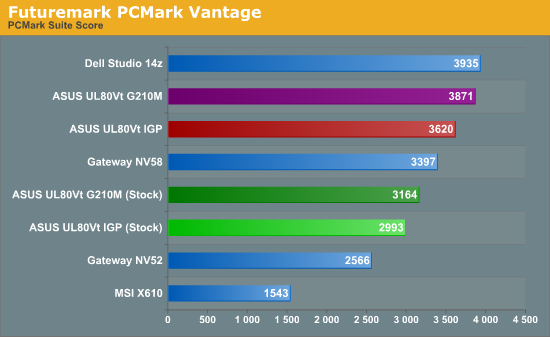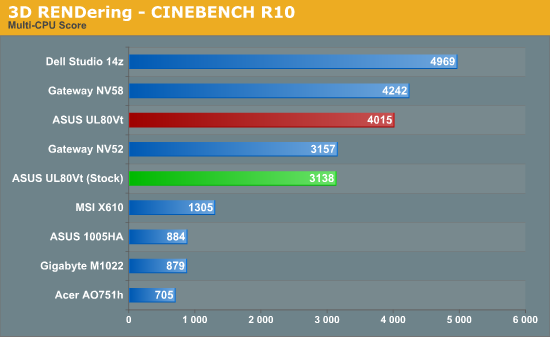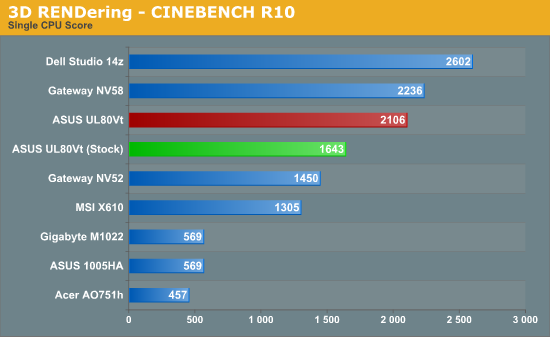ASUS UL80Vt and G51J: Going for the Gold
by Jarred Walton on December 15, 2009 1:30 AM EST- Posted in
- Laptops
ASUS UL80Vt Application Performance







With Turbo33 and the G210M enabled, the UL80Vt is neck-and-neck with the Dell Studio 14z in PCMark Vantage, the most comprehensive picture of general application performance. PCMark05 places more of an emphasis on CPU clocks, so the 14z with P8600 ends up around 30% faster. That ~30% advantage holds when we move to CPU intensive applications like video encoding and 3D rendering where the 14z is 38% and 23% faster, respectively.
If you prefer battery life and want to disable the G210M and run the CPU at stock speed, the gap between the UL80Vt and the 14z grows substantially. PCMark Vantage shows a 31% advantage, PCMark05 75%, CINEBENCH 58%, and video encoding around 75% - not that you're likely to try doing video encoding or 3D rendering while unplugged on this sort of laptop.
If you want a different comparison that shows exactly why we're so keen on CULV laptops, take a look at the stock IGP configuration of the UL80Vt and compare that with any of the netbooks. In that case, the UL80Vt is over twice as fast in PCMark05 and 2.5 to 3.5 times faster in CPU intensive tasks like video encoding and 3D rendering. Sure, the UL80Vt costs over twice as much as a typical Atom-based netbook, but there are plenty of other CULV laptops with prices starting at $400 for the Acer 1410. The PCMark figures are a good indication of our experience: dual-core CULV is dramatically faster than Atom, to the point where if price is similar we wouldn't even consider Atom.










66 Comments
View All Comments
JarredWalton - Tuesday, December 15, 2009 - link
Sorry... I didn't think to test the mic. Built-in mics range from passable to lousy, so any time I use a mic I use a headset.Devo2007 - Tuesday, December 15, 2009 - link
I commented on the first article that seemed to have an odd layout (conclusion on the first page, etc.) so it's only fair that I chime in with an update. This one was much better! I liked getting the introduction, then an overall opinion on the next page. Kudos for also providing a quick link to view the technical details of the laptop as well.Visual - Tuesday, December 15, 2009 - link
Not having both laptops at least on the same page if not the same graph for the performance benchmarks was a weird choice though. I realize they are in completely different leagues, but still an easier comparison between the two would have been nice.JarredWalton - Tuesday, December 15, 2009 - link
The games are all run at completely different settings (for obvious reasons). 3DMark06/Vantage also run at 1280x768 on the lower spec laptops, unless you connect an external LCD. Since they all run at that setting I've kept the results. I thought about combining everything, but I've got two sets of spreadsheets with results: one has the high-end stuff and the other has low-end options. Putting together all the charts already takes forever and a day, and combining them all would potentially increase the time and just make the charts more confusing. (I'm still not sure I did the right thing on the last few charts where I combined results.)davepermen - Tuesday, December 15, 2009 - link
my powerplans never mess up. never did on vista, never do on win7. but i never install specific powerplan-tools, just a clean os install, and then let it be (and reconfig the power plan, like the password-after-standby and such).so far, i haven't encountered your issue on all the machines i've tested.
weird.
iamezza - Wednesday, December 16, 2009 - link
It has happened to me fairly often since I did a clean install of 7 on my Desktop PC. Password on resume, hard drive timeout and monitor timeout are the ones that get reset for me.cerebro - Tuesday, December 15, 2009 - link
Just put SetPower on it (google it). It lets you configure the power settings based on time of day and takes into account whether the machine is plugged in or not. It uses scheduled tasks so it doesn't consume resources other than when it is switching plans for you.aos007 - Tuesday, December 15, 2009 - link
I have on the other hand ran into them quite often, especially on my laptop. I have the opposite problem - the damn thing just won't stay asleep and often I wake up finding it's on even though the lid is closed. And if it's not plugged in, you can imagine what kind of charge is left in it. I was getting it in Vista and I'd say it's probably even worse in Windows 7. I am guessing it has something to do with Microsoft's implementation of DLNA, I mean access to multimedia libraries and streaming. Microsoft specifically talks about devices needing to be able to wake up remotely when queried. That's all fine and dandy and even desired in a desktop but a laptop should really be a special case. Especially once the lid is closed.The0ne - Tuesday, December 15, 2009 - link
I have issues too, with and without clean installs. Sleep sometimes doesn't even trigger. Screen goes blank, screensaver, even though I turned it off. Very strange behaviors in Windows 7. This is for laptops though and I have not encounter anything with deskstops. There are other various strange little quirks in Windows 7 as well.Most annoying thing is the windows explorer restarting itself. I think I figured out what's been causing this problem and have since accidentally fixed it. Its was one of the codecs with the k-lite codec full package that was screwing things up. Bastard. None of the tricks via Google worked for me except for this.
JarredWalton - Tuesday, December 15, 2009 - link
I'm guessing that it's possibly linked to the OEM software. Still, I'm 99% positive I had it happen with the Clevo W870CU and a clean install of Vista. I know on an Acer system I uninstalled every piece of software that was loading at startup, along with removing/disabling some services, and it STILL happened. Gah! I also don't like how many OEMs limit your setting on the critical battery percentage to 5%... I had to manually hack that on the G51J to make it 1%.At any rate, it was something I've encountered enough during the past couple of years that I finally wanted to mention it. ASUS on the UL80Vt is particularly annoying if you use the button on the keyboard (the ExpressGate "power" button) to switch between plans, as it will jack with all sorts of settings. To my knowledge, there's no way to edit the defaults that it sets on most of the plans (i.e. the Power4Gear Battery Life option will turn on "auto-hide taskbar" every time you activate it).